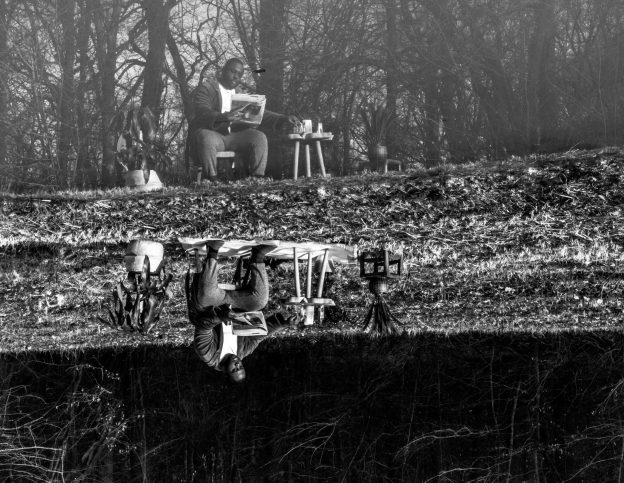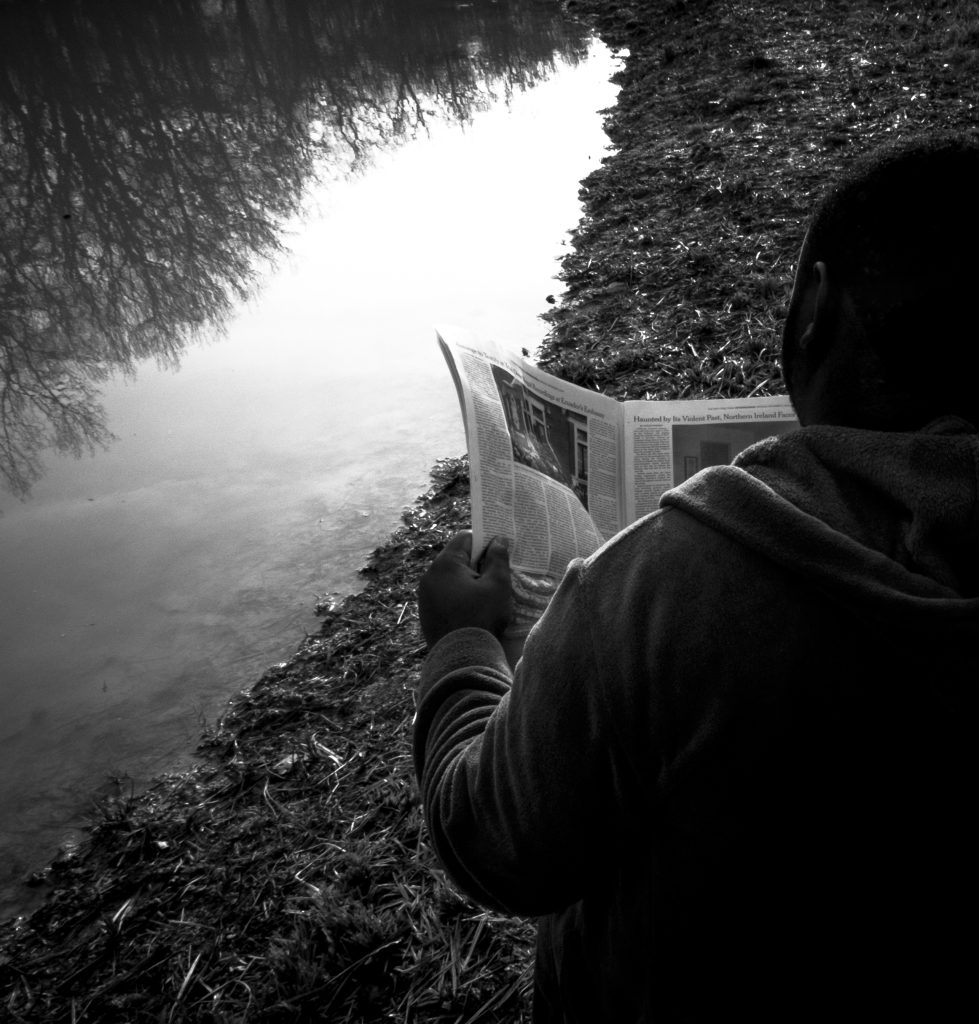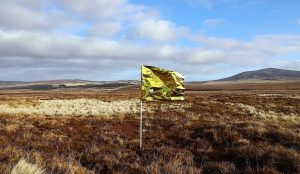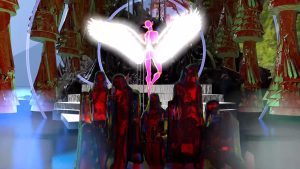with DECOLONISE THIS PLACE
photographs by MICHAEL STEFFEN
in frame KAVOY A. ASHLEY
JOSEPHINE APRAKU (JA): Growing up as a Black kid in Germany in the ’80’s and ’90’s wasn’t a walk in the park to say the least. My white mother was pretty aware that my experiences growing up would be vastly different from hers so she did her best to create spaces for me that could be empowering. Being Black and experiencing racism in Germany, a nation that imagines itself as a white nation—especially since its participation in colonialism—led me to be incredibly interested in social justice and all kinds of interpersonal relationships for as long as I can remember.
JULE BÖNKOST (JB): As you just put it, in Germany, being ‘German’ is associated with being white or otherwise you are classified as ‘foreigner.’ Thus, from early childhood on, racism assigned me the white privilege to feel welcome and belonging, to be part of the ‘German us.’ Simultaneously, it made me believe that my everyday experiences are universal and not racial and specifically white experiences. All this remained unspoken. In school, besides with regard to National Socialism, I did not learn anything about racism let alone whiteness. To me, racism did not have anything to do with me. I believed that it was intentionally mean behavior of individuals. To be ‘against racism’ meant to me, first and foremost, to be against Neo-nazis. It was not until I was a young adult that my interest in the topic of race started growing and that I began to become conscious of what it means to be white. And that was a long road.
JA: What you describe reminds me so much of what I learned in school: racism equals Nazis and Third Reich. Often, especially in school, if and when we talk about racism in Germany, this is what we talk about. This is very particular to the German racist discourse—antisemitism and racism often aren’t analytically distinguished. Which is problematic in and of itself.
I remember reading The Diary of Anne Frank in sixth grade. Since in school we never really dealt with German colonialism, anti-Black racism or the Prussian slave trade, I felt at the time that I could connect my personal experiences of racism to the struggle of Jewish people in Germany. I remember feeling uneasy whenever another pupil would say that they couldn’t understand how something like the Holocaust could possibly have happened. To me it wasn’t a mystery at all—I experienced microaggressions on a daily basis.
What inspired you to dig deeper and deal with whiteness as relevant to your identity?
JB: Decisive was my studies. I studied in the American Studies Program at Humboldt University of Berlin. During my bachelor’s and master’s degrees, I took classes in the fields of gender studies, postcolonial studies, critical race theory, and whiteness studies. Studying the work of scholars like W. E. B. Du Bois, James Baldwin, David Roediger, Ruth Frankenberg, and Eduardo Bonilla-Silva nurtured my interest in examining and questioning power relations and specifically racial relations. I devoured the works of Black feminists like Alice Walker, Toni Morrison, bell hooks, and Patricia Hill Collins, from whom I learned so much. The examination of race in the USA also opened my eyes to how racism functions in Germany. Yes, race in the USA and race in Germany are not the same, but at the same time, there are so many similarities of how racism, as a global phenomenon, works in both countries. This seemed and still appears so obvious to me. I realized that race was also right in front of me. I began to focus my research on race in the German context with my dissertation, in which I analyse the construction of race discourse in current German English-language textbooks. This led me not only to study the German anti-racism movements but also to honestly investigate my own white identity, race-based privilege, and implicit racial bias in conjunction with my intention to act antiracist. Starting with critically reflecting on how I, as a white person, could write on race, I began to explore how my whiteness affects my perspective as a scientist as well as my daily life and actions. I was eager to know everything about the possibilities for white efforts against racism as well as about its limits and pitfalls. Thus, I also became increasingly aware of the necessity of taking action as a white antiracist. Therefore, I started to volunteer and then work for a small non-profit, anti-racism organization next to working on my PhD. And that was also where we met and made plans for our collaboration. As it happens you were studying at Humboldt, too. How did you experience the topic of race during your studies?
JA: When I started studying African studies and gender studies I found it to be very exhausting. There too I was amidst a mostly white student body and that strongly shaped each of the seminars I attended. Common questions were: “But why does my friend call herself Black—it’s such a derogatory term?” or, “Is the criticism of racism by me, a white person, even valid?” I was bored by these perspectives that seemed to take up all the space any given class provided. It took me a while to understand that, in a way, I was ahead of most of the others in class—my Blackness had always been part of my identity. To me this wasn’t new or complicated. When I came to terms with that I was able to refocus my studies and was always interested in asking myself, “How does theory X relate to theory Y? How do they help me to think even further?”
I fell deeply in love with all things critical theory, specifically critical pedagogy. When I read Freire or hooks, I finally felt understood, I felt that they had written the words to what I had thought and felt for a long time.
Strangely we’ve never really talked about this: many white people study topics such as race, class and gender. How come it stuck with you? How come it had such a profound impact on you?
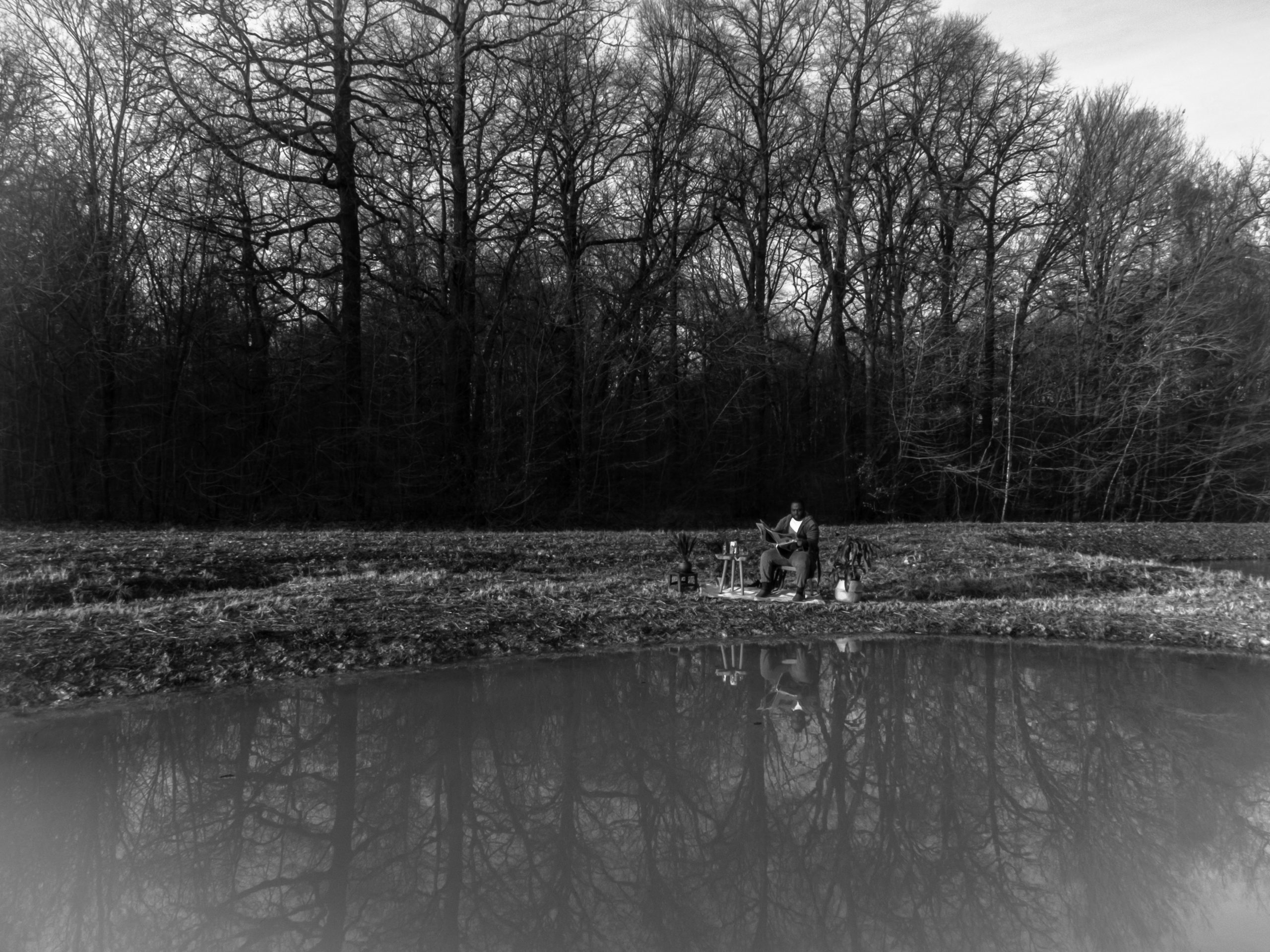
JB: I have been thinking about that a lot. I remember how during my studies some of my white fellow students seemed annoyed by the recurring topic of race. The race-gender-class trilogy was ridiculed more than once. Why did our engagement differ so much? I have not found the answer yet. However important it is, learning about race does not make white people automatically understand racism let alone act against it. If it only was that simple. Coming into contact with the topic of race can sometimes even harden whites’ racist positions. I believe that no white person can develop an antiracist identity without experiencing some kind of defensiveness in the process. But I think that this development is encouraged if the learning about race falls on some kind of fertile ground. I grew up in an environment that encouraged critical thinking and a sense of social justice and I have had close interracial friendships since I was young. In my case, I believe that was important. That is not to say that I did not experience any white defensiveness when I began to learn about racism but, looking back, I think this helped me navigate through it.
JA: I find the topic of defensiveness very interesting. When we talk about defensiveness with regards to race and racism, we do so mostly thinking of white people who start learning about their involvement in racist power structures. We very rarely talk about the process of Black people and People of Color actively learning about those same structures. I find this interesting because it seems that here, too, whiteness is in the center of attention.
As I’ve described before, from a very young age on I was invested in social justice—mostly because I experienced how unjust our society is. Yet I too was at times very defensive about my position as a young Black woman within social structures, more specifically racism. I didn’t want to be framed as the victim, not of sexism, not of racism, not of any ism really. So I too didn’t want to acknowledge how racism was a thread in the fabric that is my experience. Simply put—if I didn’t perceive racism in my everyday life, I wasn’t a victim in my everyday life.
Another aspect that I find relevant is that the racist discourse in Germany is constructed in a way that imagines racism to be deliberate—which most of the time it isn’t. So the idea is that only people who intentionally do or say racist things, the bad people, are racist. Since I grew up being surrounded by whiteness I believed that to be true, while at the same time knowing that what I experienced on a daily basis was racism: double consciousness, as W. E. B. DuBois, who briefly studied at the same university in Berlin as you and I did, put it.
This is, in part, why I find it to be important as well as necessary to give people who experience racism a break. Learning about racism, even though we experience it, is a process for us, too. We aren’t born to be critical of structural racism.
JB: Similar to your experience, studying critical race pedagogy and critical whiteness pedagogy gave me a context that helped me to understand my racial experiences. For example, in school I did not learn anything about structural racism and whiteness. That is itself a manifestation of systemic racism, in which, along with others, the educational system and educational institutions participate. Also, my research made me want to become active in the field of antiracism education myself. Especially, because here, I increasingly came to see opportunities for me to work against racism, namely by teaching, reaching, and engaging other white people by drawing from my experiences of being a white person learning about racism. I started lecturing as an assistant professor on the topic of race and education at Humboldt University. Especially in conversation with Black and PoC students, I quickly found myself as a learner—which I am up to this day. This also applies for all-white teaching contexts, from which I learn a lot about how race operates and affects everyone including me and my teaching. Yes, I also repeatedly found myself doubting whether I, the white woman, should and can be the one teaching other people about racism. White anti-racism role models became extremely important to me, and still are. They encourage me to cultivate a positive, rather then paralyzed and destructive, anti-racist white identity. I also grew increasingly interested in allyship and coalition building. Today, with regard to our partnership, the Institut für diskriminerungsfreie Bildung, I see one of my important tasks is to constantly reflect on my racialized white perspective and the specific opportunities, pitfalls, and limits that come with it for my work.
JA: All of the things you said are reasons why I enjoy working with you. I can count on you. And because of that there are many jobs within our field of work that I don’t have to do: I don’t have to deal with white fragility, for example. Also, I find it valuable that when we facilitate, say, a workshop, you can draw from your experience regarding your white identity and your racialized experience and perception of society. I can’t do that, I am not white and I don’t know what it feels like nor can I imagine being white. When we work together I want us to set an example of what allyship can look like. It isn’t as complicated as many white people actively wanting to learn about racism make it out to be. I think it is quite simple actually: take responsibility and do the work, not for others but find the value for you as a white person in deconstructing racism. What is in it for you? Finding your personal motivation, I think, is a good idea either way, because critiquing societal structures isn’t a one day event where you are handed a donut and a coffee and are wished well. It is hard and sometimes lonely work that, in order to be sustainable needs to be done on a daily basis.
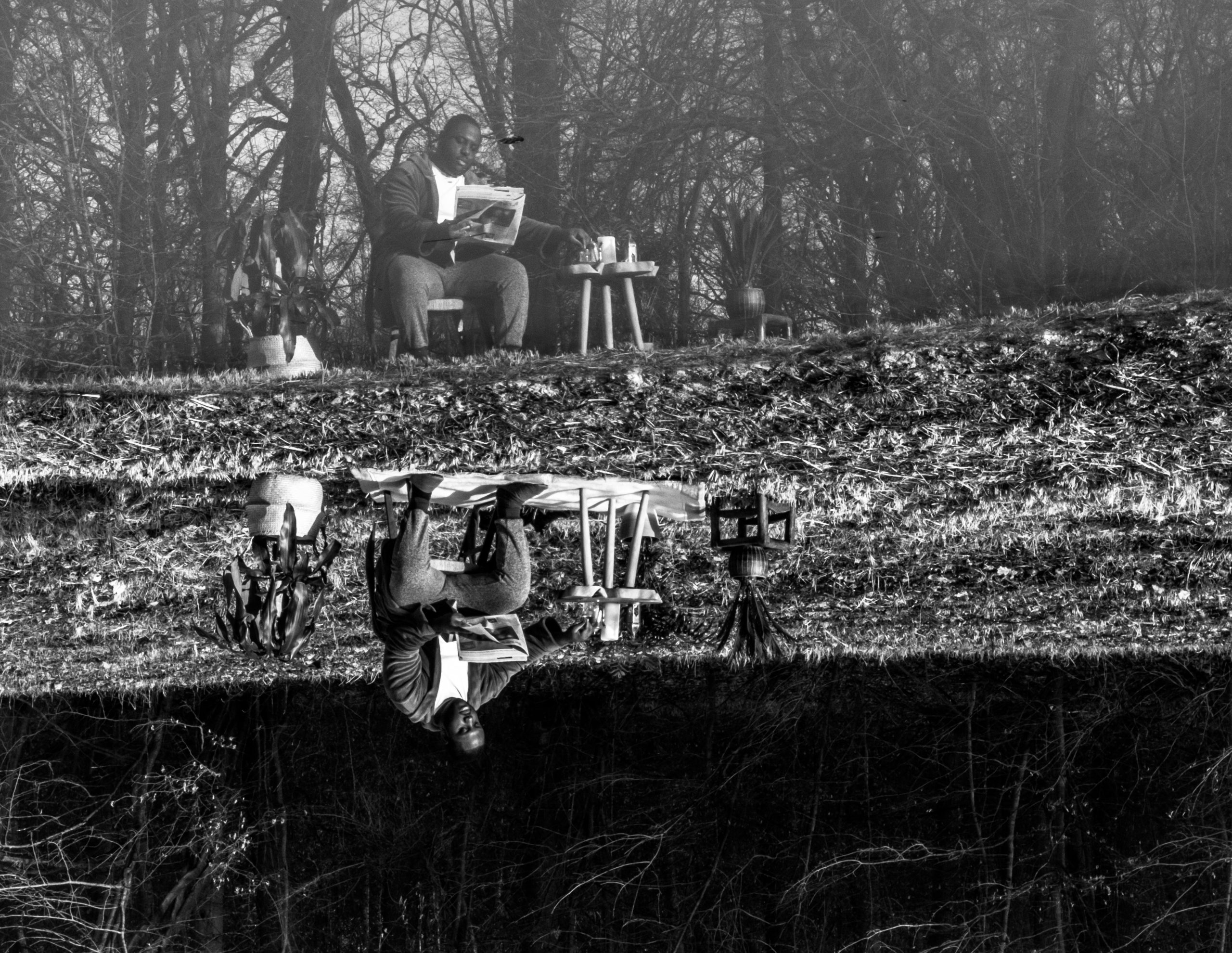
Listening requires time, which is often lacking. Listening also asks strongly to read between the lines. To truly listen means, that the trauma that has been inflicted is passed down from generation to generation. It needs to be replaced by healing, redefinition and empowerment.
Mihir Sharma once said that we need to listen with a multiplicity of ears. Then, to truly listen means that we allow ourselves to look at different modes of thinking by formulating a strategy of openness to dialogues that is seeking to disconnect from an epistemic as well as political way of knowing that is centred around western knowledge.
To truly listen means to listen with a multiplicity of ears that sees change in the power of people’s imagination in liberating and freeing themselves from mental slavery, and the overall colonial matrix of power (Mignolo & Walsh 2018: On Decoloniality) with its coloniality that lives on. To truly listen means to allow decolonial thought to takeoff as a necessary means to imagine societies that are freed from colonial and imperial logics. To truly listen means that it is a must to acknowledge different ways of knowing, thinking and being. Imagination creates places that are not there yet. It is the elixir of freedom. Imagination is what thrives human experience. Imagination is what changes physical spaces and surroundings as well as how people feel about it.
MICHAEL STEFFEN
ISSERSTEDT, GERMANY 2020
JOSEPHINE APAKRU & JULE BÖNKOST in dialogue
Josephine Apraku & Jule Bönkost are co-founders of the IDB | Institut für diskriminierungsfreie Bildung (Institute for Anti-Discriminatory Education) in Berlin.
MICHAEL STEFFEN photographer
KAVOY A. ASHLEY in frame
With photography as their medium of choice, Michael Steffen aims to bring injustices related to economic inequalities, race, and human rights to the foreground. “Another world is not only possible, she is on her way. Maybe many of us won’t be there to greet her, but on a quiet day, if I listen carefully I can hear her breathing.” With the words of Arundhati Roy, hope as well as empathy, Michael believes in a more just and equal world for all.
Find Michael @michael_steffen_photography and Kavoy @kevynevy123.
© Copyright for all texts published in Stillpoint Magazine are held by the authors thereof, and for all visual artworks by the visual artists thereof, effective from the year of publication. Stillpoint Magazine holds copyright to all additional images, branding, design and supplementary texts across stillpointmag.org as well as in additional social media profiles, digital platforms and print materials. All rights reserved.
